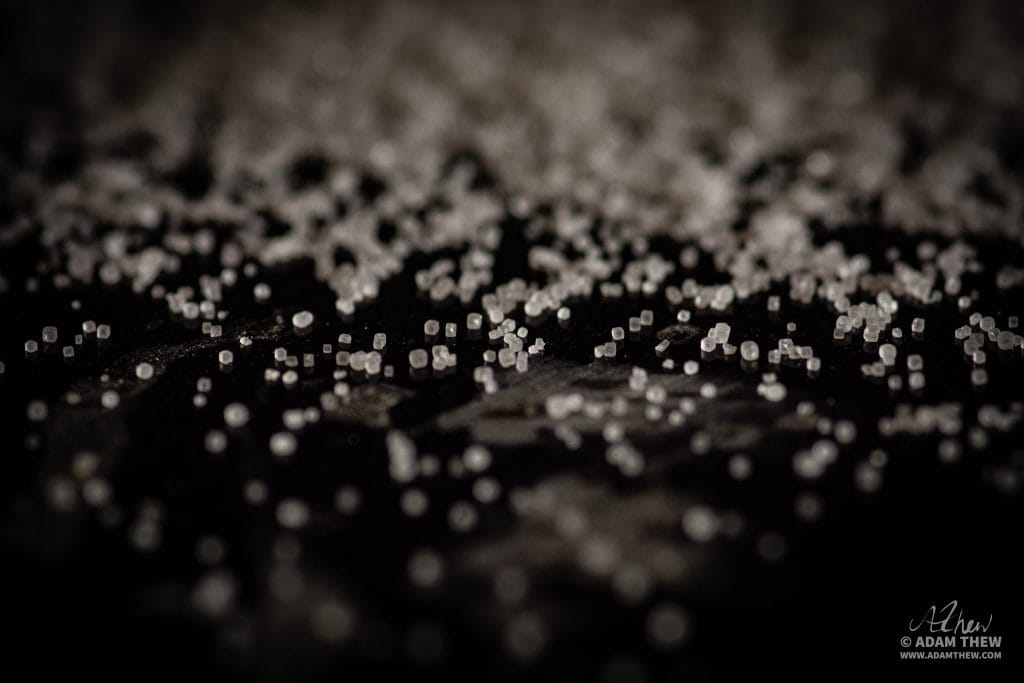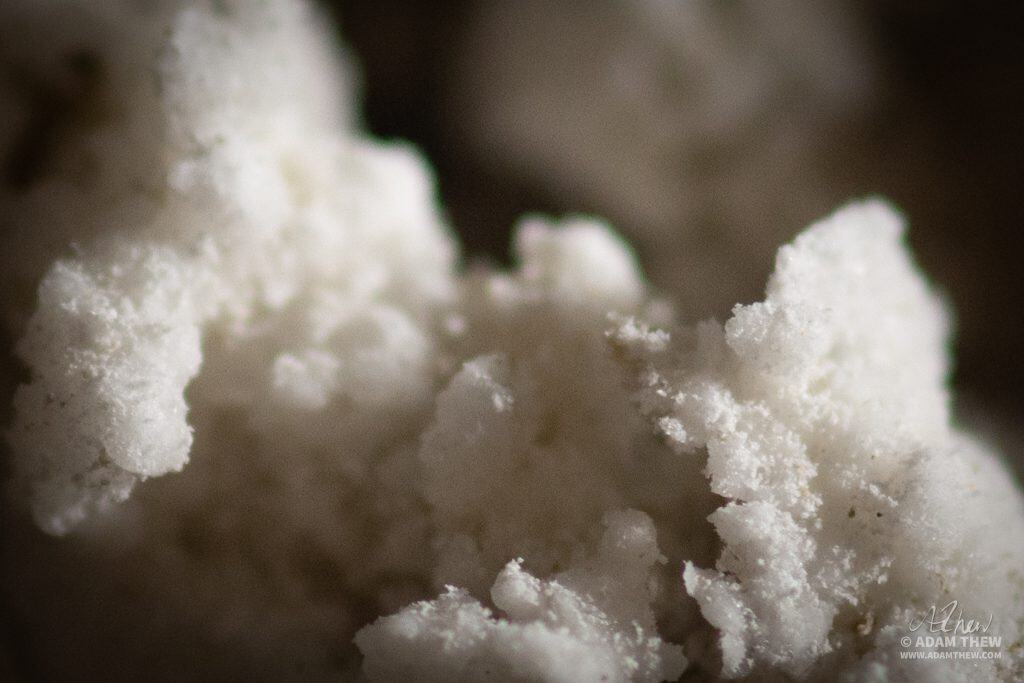Imagine with me for a moment, you’re a miner, in the 1920s. Your employer has commissioned you and your fellow workers to dig extensive tunnels beneath the rocky ground of the Verde Valley. Somewhere, in the midst of your work, as you trace through the rich layers of salt, you find it—a body! This body, though obviously not recently deceased, was still shockingly well-preserved. How could this be? The answer is found quite simply in the nature of salt.
We’ll get back to this mine in a few moments, but first, I want to discuss the origins of this humble mineral.

You might be surprised to learn, Halite (NaCl), the mineral form of salt, is the product of a chemical reaction occurring within sedimentary rocks or water, equal parts Sodium Metal (base) and Chlorine Gas (acid). The resulting ionic compound takes the form of white crystals, often bound to other minerals before refinement.
You can find an abundance of salt in large white veins under the crust of the Earth, some seemingly reaching endlessly into the ground; if it does not reach the surface through natural means, such as brine, salt licks, or another way, it can be mined.

Bodies of water, such as salty lakes or ponds, dead or alive, will also accumulate in gratuitous amounts. When the water has stagnated long enough for the process of evaporation, the same chemical reaction, as mentioned above (acid + base), has an opportunity to occur. Sea Salt, from saltwater, can also be obtained by evaporation.
Did you know there are multiple families of salt? To name a few, there are the chloride family, sulphate family, nitrate family, sodium and even copper family. It is from the chloride family that we get sodium chloride; that is, table salt.


Salt is crucial to our existence. In fact, every cell in your body is somehow laced with it. Too much of it can, of course, be fatal; and we all know the devastating effects of salt water consumption.
There are a number of famous salt caches across the world: the Salzburg Mine in Austria, the Dead Sea of Israel (also known as the Salt Sea), the Salt Mines of Detroit, The Salt Lake of Utah, to name a few. Each of these has, in some way, influenced the industries, peoples and animals, and the economies, built around them, and often, because of them.

The Verde Salt Mine, one of the oldest in North America, was no small player in Arizona’s early economic development, and undoubtedly played a starring role in the lives of those who called the [Verde] Valley home. Use of this mine, while certainly pre-Columbian, made evident by discoveries of rare artifacts used by indigenous miners, dating pre-1490s; may extend much further into history. According to some experts, it might have been operational up to 2,000 years ago.


Ancient cultures, such as the Sinagua, and the Hohokam, who were known to have extensive trading routes, profited greatly in the exchange of salt and other goods; much of the bounty gathered from this salt mine.


Ancient Sandals 
Ancient Hafts 
Ancient Cedarbark Torches


For reasons unknown, the site fell out of use for a long time. It came about shortly before the establishment of Fort Verde, in 1871, that interest in this large deposit was renewed, and so operations began once again. Soldiers and settlers alike quarried here, and carried away large stocks for their recompense.
Later, during the 1920s, commercial mining began. The Arizona Chemical Company, which owned the mine, employed around 75 men, half of which were local Apache. Over a dozen large tunnels were excavated through the strata of salt, clay, and gypsum; work was terrestrial and subterranean, and a number of above-ground structures are still seen today. It became one of the most productive mines in the country.

Market needs began to change, and while successful, it could not compete with the richer, purer ore, entering the market from the German sector, and thus, in 1933, the mine was forced closed, once again. Attempts to revitalize the mine, even as recently as the 1960s, were fruitless, due to ore-purity. Market demands require a minimum of 99% purity, while this deposit can only offer 92%. This, in conjunction with larger deposits in the U.S. and Canada, ensures the mine will lie dormant into the foreseeable future. The U.S. Forest Service is currently working to breathe new life into this old site through the development of an interpretive trail.
As mentioned in my opening story, the mummified remains of an ancient miner were discovered here. So, how did the body last so long? Let’s take a trip through time and space, to Ancient Egypt. We are now one of pharaoh’s physicians, tasked with the embalming of the king. Of the different steps involved, perhaps the most important, is the covering of the body and parts of the interior, with natron, a type of salt known for its drying properties. Once dried, we carefully remove the natron from the body before taking our next steps.
So, the reason Egyptian mummies survive is because the bodies are drained of moisture. Moisture is the breeding grounds for bacteria which will essentially eat the corpse over time. What of our Verde mummy? Well, salt would have acted as a microbial inhibitor, preventing those natural processes from fully decaying the body.
Perhaps, while unimportant to the purposes of this article, you might be interested to know more about this ancient miner’s condition upon discovery. His head was never found (presumably removed during dynamite explosion), and his body had been flattened; obviously the unfortunate victim of a cave-in. Also interesting to note, this was not the only body found here.
Salt was a major player in the ancient world. Of the many roads that led to Rome, perhaps the most-famous, and busiest, was known as the Via Salaries; that is, the Salt Road. It was from Roman culture and their affinity for salt, and their [soldier’s] monthly pay, known as “salarium,” we get the word “salary.” Some people believe the Roman soldiers were paid in salt, but this is likely a reference to the Salt Road, which they protected. Interestingly, Greeks and Romans would purchase slaves with salt, and referring to the cost, the phrase “not worth his salt,” came into existence. This could also be said of the soldier who’s pay was cut. So important was Sal (their name for salt), it was “immortalized” in Salus, their goddess of health.
Salt is even mentioned, on more than one occasion, in the Holy Bible.

"Season all your grain offerings with salt to remind you of God’s eternal covenant. Never forget to add salt to your grain offerings." - Leviticus 2:13
To the Hebrews, the preservative properties of salt, when compared to God’s enduring covenant, would have been an easily-understood analogy.
If I were to list all of its applications, both potential and proven, this article might extend indefinitely. You can be sure, however, that its resume is unrivaled and very impressive. So great is its influence, that it will undoubtedly continue to, in its own way, shape our world. Next time you’re sitting down to dinner with your favorite seasonings, or watching them salt the roads in a snowy area to prevent icing, or enjoying a scoop of your favorite ice cream (yes, you can thank salt for that, too), you’ll undoubtedly have a new appreciation for this White Gold.

Sources
Morris, Earl Halstead. “An Aboriginal Salt Mine at Camp Verde, Arizona.”
www.visitcampverde.com. “Verde Salt Mine.”
www.10upon10.com. “Acid, Base & Salt”
Danilo Alfaro. “What Is Rock Salt?”
www.historycooperative.org. “The History of Salt in Ancient Civilizations.”
www.time.com. “A Brief History of Salt.”
Contribute to Arizona Jones
Well, I hope you found this article to be both informative and entertaining. If you find value in my work, please help me continue my work by supporting me through one of the following:
GiveSendGo: https://www.givesendgo.com/theazjones
Patreon: https://www.patreon.com/theazjones
Store: https://www.theazjones.com/store




